Supporting materials
Below are the supporting materials and technical reports to read alongside the Access Report year 1.
On this page
Download the 'Access Report: Year 1' as a word document
Evidence supporting access reporting
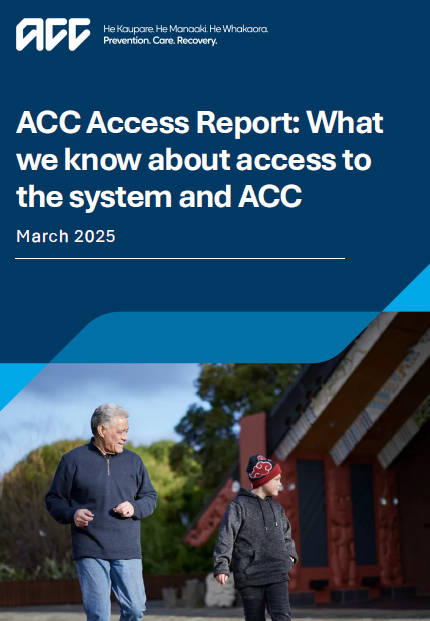
What we know about access to the system and ACC
A summary of research on Māori, Pacific people, Asian people and disabled people’s access to the health and social system, and the Scheme.
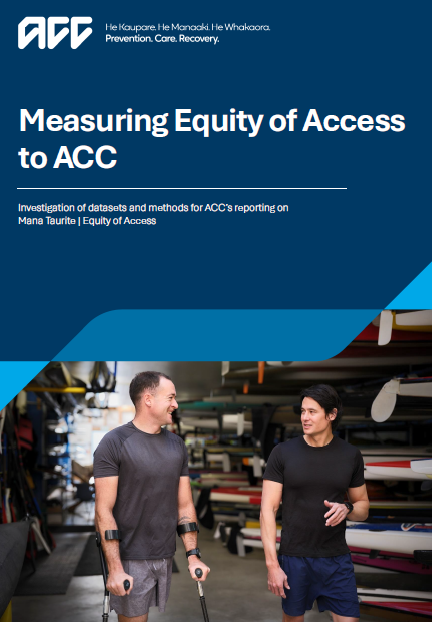
Measuring Equity of Access to ACC
Investigation of datasets and methods to use for ACC’s reporting on Mana Taurite | Equity of Access. A report outlining the rationale for our access reporting methodology.
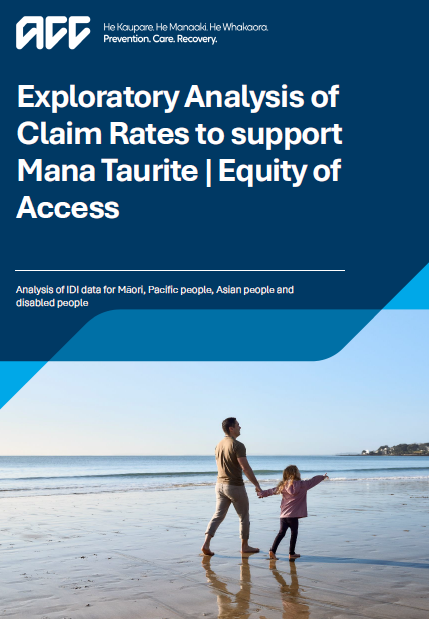
Exploratory Analysis of Claim Rates to Support Mana Taurite | Equity of Access
Analysis of IDI (integrated data infrastructure) data for Māori, Pacific people, Asian people and disabled people. A report outlining the results of analysis undertaken in the StatsNZ research database. The analysis looked at associations between demographic and socio-economic factors and ACC claim rates for Māori, Pacific people, Asian people and disabled people.
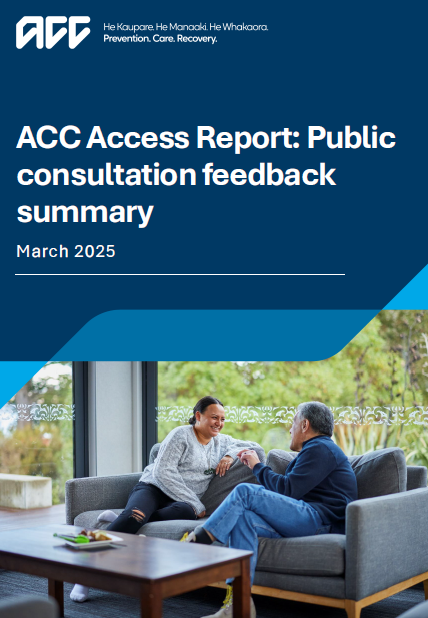
Access Report: Public consultation feedback summary
A summary of feedback and ACC’s response to the March 2024 public consultation on access reporting methods.
Our Strategic Approach
It sets out our strategic intentions and outcomes, and what we’ll do differently to achieve them.
Importantly, Huakina Te Rā also sets out the vision of where we want to get to:
Tōnui ake nei | A Thriving Aotearoa
Huakina Te Rā means to ‘open the sail’. It’s the command that calls ACC to action, engaging the sails of our waka into momentum towards our vision.
Underpinned by Te Tiriti o Waitangi | The Treaty of Waitangi, our strategy seeks to create meaningful change through equitable wellbeing outcomes for the people we serve.
It has been developed with a dual framework that acknowledges both Te Tiriti o Waitangi | The Treaty of Waitangi partners, as represented by a waka hourua, or double hulled canoe. The dual-hulled waka of Huakina Te Rā facilitates Māori and non-Māori to meet on the papanoho. The papanoho is a location, and a concept, or metaphor, that sits upon the kīato which keeps the two hulls secure. The papanoho is where people from the two hulls meet, and a reciprocal relationship is facilitated and understanding is formed, enabling all members of the waka to adapt to the needs of the collective.
The dual-framing is reflected in ACC’s goals. Mana Taurite | Equity is our dual-framed goal for all people in Aotearoa New Zealand to experience accessible services and improved outcomes. Achieving Mana Taurite means improving equity of access, the service experience and outcomes for Māori while ensuring the mana of the recipients is upheld in the process. Equity is helping people to get the support they need, when they need it, to recover from injuries.
We have chosen to adhere to the dual framing of Huakina Te Rā, Mana Taurite | Equity and the legislative requirement to report on Māori by creating a Māori-centred workstream. We consider this approach to embody Te Tiriti o Waitangi in action. This is because it provides a dedicated space for Māori-centred approaches to be employed (rangatiratanga) to better understand access, barriers, and causes of barriers to the Scheme.
The workstream is modelled on the waka hourua. It will prioritise Māori knowledge, methodologies, data sovereignty and intergenerational aspirations by using strengths-based approaches and Māori-centred methods of engagement. Where necessary, non-Māori methodologies will be used to gather required data. This partnership-based, reciprocal approach will achieve the goals of the collective, whilst simultaneously acknowledging both Māori and non-Māori have their own needs and responsibilities.
We will focus on specific groups in the Māori community who experience additional challenges to accessing the Scheme, or who engage with it successfully; this is likely to involve engaging with iwi entities to reach these groups. We have chosen to take a targeted, tailored approach because we have established our foundational evidence about levels of, and disparities in, access to the Scheme for Māori at a population level i. We have also synthesised population-level evidence about barriers and reasons for those barriers ii . Subsequent access reporting will enable ACC to fill specific evidence gaps, and improve access for people who most need additional support to recover from injuries.
We will continue to use advice from ACC staff dedicated to working with Māori and seek advice from agency partners (including Te Puni Kōkiri and Stats NZ) on the Māori-centred workstream and engagement approach. This will include connecting to ACC’s Mana Taurite | Equity Data Roadmap project. More information on how we are achieving our Mana Taurite | Equity goal, which includes the interventions currently targeted at improving Māori access, experience and outcomes is available in ACC’s 2024 Annual report.
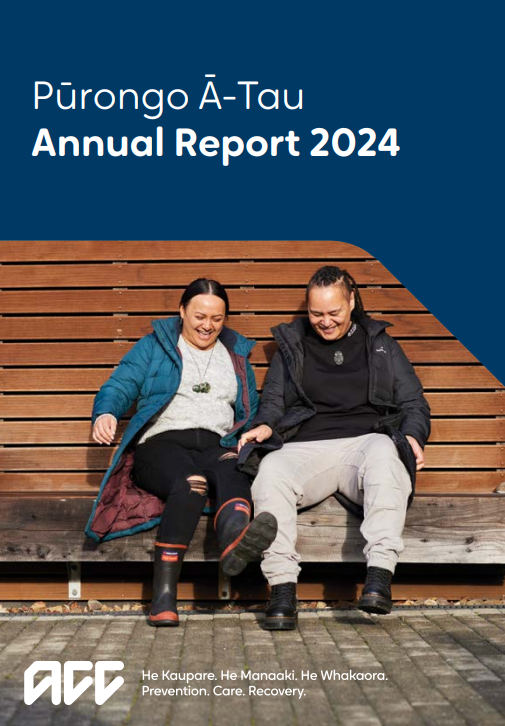
Annual Report 2024
Highlights our achievements throughout the year and outlines our financial and non-financial performance. It describes our results for 2023/24 and reports on how we performed against our strategic intentions, as set out in our Statement of Intent and Service Agreement.
Our injury prevalence information
Proportion of people who indicated an injury in the General Social Survey (GSS) and had an ACC claim.
The most recent available injury prevalence data was collected in the Statistics New Zealand General Social Survey (GSS), a nationally representative survey of the New Zealand adult population. The three earliest iterations of the GSS (2008, 2010 and 2012) included questions about physical health problems or injuries resulting from crime, work, traffic accidents, or accidents at home or elsewhere.
GSS data is in the Stats NZ research database, the Integrated Data Infrastructure (IDI). We linked the survey data to ACC claims data in the IDI to see how many of the survey respondents who indicated they had had an injury over a 12-month period between 2008 and 2012, also had an ACC claim with an injury date in the same period. The claims data includes claims that employers provided to ACC through the Accredited Employers Programme (AEP).
We found that 21% of the survey respondents (n=24,741) indicated they had had an injury over a 12-month period between 2008 and 2012. Of that 21%, an estimated 56% had an ACC claim with an injury date in the same period. From this, it can be deduced that 44% of respondents who indicated they had had an injury had no associated ACC claim.
We acknowledge that the data is 12 years old and that some of the responses to the injury-related questions in the GSS may relate to illnesses without an external cause, rather than injuries of a similar profile to those covered by the Scheme. This means this analysis serves as a beginning for understanding disparities between people who are injured and have an ACC claim or not. We are developing our research approach further. See ‘Evolving our research approach’ on the ACC Access Reporting page.
Proportions of Māori, Pacific people and Asian people who indicated an injury in the GSS and had an ACC claim.
We used the linked GSS and ACC claim data in the IDI to estimate the proportion of Māori, Pacific people and Asian people iii who indicated an injury in the GSS and had an ACC claim.
Firstly, we estimated the injury rate for each population. This is the proportion of people who indicated in the GSS that they had been injured over a 12-month period between 2008 and 2012 (injured GSS respondents).
Then we estimated the claim rate for each group. This is the proportion of GSS respondents who had at least one accepted ACC claim with an injury date in the 12 months prior to taking part in the GSS (GSS respondents with a claim).
Finally, we estimated the proportion of respondents who indicated an injury and had an accepted claim. We did this by dividing the number of injured GSS respondents, by the number of GSS respondents with a claim (Figure 1).
Among injured respondents, Māori, Pacific people, and Asian people were less likely to have claims than non-Māori, non-Pacific people and non-Asian people, respectively. However, the only statistically significant difference was the gap between Asian and non-Asian, which is the largest of the ethnicity-based gaps. Unfortunately, it was not possible to identify claim rates for injured disabled people using this method iv.
Reported ethnicity |
Proportion of injured respondents with claim |
95% confidence interval |
|
Māori |
50% |
44% - 56% |
|
Non-Māori |
56% |
55% - 58% |
|
Pacific |
48% |
35% - 61% |
|
Non-Pacific |
56% |
54% - 57% |
|
Asian |
43% |
33% - 54% |
|
Non-Asian |
56% |
54% - 58% |
Figure 1: Proportion of GSS respondents who reported an injury that had an accepted claim for Māori compared to non-Māori, Pacific compared to non-Pacific, and Asian compared to non-Asian. Source: IDI data.
We have used total ethnicity response (rather than prioritised ethnicity response) for access reporting, because this method provides a more complete picture of the populations v.
Proportions are based on population weighted data and error bars represent 95% confidence intervals. Error bars are lines on a graph that show how much the data might vary. They help show how unsure we are about the measurements. The 95% confidence interval shows where the true average is likely to be. The middle of this range can change because each sample gives slightly different results.
What we learnt from collecting injury prevalence data using an ACC survey.
We explored the possibility of collecting more recent injury prevalence data by adding injury questions to ACC’s only survey with non-claimant respondents, the ACC Brand Tracker. This survey measures the general public’s engagement with ACC interventions and campaigns. The survey is carried out by independent company The Research Agency (TRA), and data is collected monthly with a sample size of approximately 500 New Zealanders.
Our analysis of Brand Tracker data collected between October 2023 and August 2024 found people who had had an injury were more likely to agree to ACC matching their survey results to internal claims data, so the injury data collected through the Brand Tracker was biased towards people with a claim. This means we cannot use ACC-collected data for access reporting.
Our claim rates analysis
For Māori, Pacific people and Asian people, claim rates are lower than for other population groups (even when adjusted for age) vi.
Injury prevalence is related to age, with younger people more likely to report an injury. The fact that Māori and Pacific people are, on average, younger than other ethnicities in New Zealand may therefore influence their claim rates relative to other groups. Age standardisation decreases Māori and Pacific claim rates relative to non-Māori and non-Pacific people, but makes little difference to the relative claim rates of Asian and non-Asian people viii.
Please see p. 22 -23 of the report 'Exploratory Analysis of Claim Rates to Support Mana Taurite | Equity of Access' for our analysis of ACC claim rates by ethnicity and age.'
The percentage of each ethnic group who had an ACC claim, by age group, per year for the 11-year period 2013-2023. A person was counted as having a claim if they had at least one accepted ACC claim with an injury date during the calendar year x. Source: IDI data xi.
Disabled people’s claim rates are higher than non-disabled people’s claim rates and children with a disability were less likely to make an ACC claim than non-disabled children xii.
Relying on Census 2018 data, we looked at claim rates for people with a disability indicator, compared to non-disabled people xiii. Figure 2 below shows that disabled people’s claim rates were higher than non-disabled people’s claim rates, both before and after 2018 xiv. Similar to other groups, disabled people’s claim rates dropped in 2020 and 2021, presumably due to the COVID-19 pandemic.
Figure 2: The percentage of people who had an ACC claim, per year, for the 2017-2021 period, by whether or not they reported a functional disability in the 2018 Census. Non-respondents to the 2018 Census question on disability are excluded from the analysis. A person was counted as having a claim if they had at least one accepted ACC claim with an injury date during the calendar year. Error bars represent 99% confidence intervals. Source: IDI data
Disabled people’s claim rates were strongly related to age, increasing for older groups. Disabled children (0-14 years) had claim rates that were 4-5 percentage points lower than non-disabled rates, while 65+ year-olds had claim rates that were 2-3 percentage points above non-disabled rates. The relationship between disabled people’s claim rates and age is striking in comparison to non-disabled people’s claim rates, which showed much less variation across age groups.
Please see p. 29 of the report 'Exploratory Analysis of Claim Rates to Support Mana Taurite | Equity of Access' for our analysis of ACC claim rates for the disabled population by age.
Evolving the approach
We consulted on our proposed methodology and received broad support for our approach. Please see the ‘Public Consultation Document Summary’ at the top of this page.
However, the annual access reports are iterative, in that one report may identify issues that warrant further exploration in a subsequent report. As a result, our methodology may need to adapt over time to appropriately investigate a key finding. When adapting our methodology, we will engage with our key stakeholders to ensure the methodology is appropriate.
Engagement to support the research underpinning access reporting has two primary purposes:
- To test and develop any changes to the proposed methodology with Māori and identified population groups (where required).
- To check findings reflect the perspective and experience of Māori and identified population groups.
There is extensive research that has been undertaken over the past 20 years on Māori and identified population groups that is relevant to Scheme access. This was reflected by public consultation submitters who noted these groups are already over-researched. We are working from the existing evidence base when developing the annual access reports. In doing this, we intend to provide drafts to key groups representing Māori and identified populations to test our findings and ensure they reflect their perspectives and experiences.
Engagement to identify and develop solutions to respond to each access report's findings
Our method of engagement to identify and/or develop solutions that respond to each report’s findings will depend on the issues that the report highlights.
ACC has established an Action Plan to support us in meeting our strategic goal of Mana Taurite | Equity. This is a live Action Plan that will evolve as we make progress in this area. The findings of the annual Scheme access report will be used to build on the evidence base that underpins the Action Plan. Appropriate solutions that respond to the findings will be considered, commissioned, and monitored through ACC’s Equity Action Plan.
Internal engagement
ACC’s Research & Evaluation (R&E) Access Reporting project team consulted with internal ACC population specific advisors throughout the development of the access reporting methodology. The R&E project team will continue to seek advice from them. ACC has established an internal cross-organisation network of key staff involved in work relevant to our strategic goal of Mana Taurite | Equity and we will utilise this group for the work.
External engagement
Through the development of the access reporting methodology and consultation on the methods and engagement approach, xvi we received advice from stakeholders, including:
- Stats NZ
- Ministry of Health
- Ministry for Pacific Peoples
- Ministry for Ethnic Communities
- Whaikaha - Ministry of Disabled People.
The consultation was an important initial first step in engaging with these key external stakeholders, and they provided extensive feedback on the proposed methodology for access reporting. We will continue to work with these stakeholders to consider how we can use best practice engagement approaches and appropriate research methods to ensure that we get quality data on injury prevalence, disparities in claim lodgement, barriers to access and causes of barriers to access for Māori, Pacific people, Asian people, and disabled people.
The population agencies also offered to facilitate engagements with relevant communities and networks to help develop qualitative research on barriers and causes, using research methods specific to the populations, for example, Talanoa with Pacific communities, and interviews and focus groups with disabled people.
Through the Whaikaha - Ministry of Disabled People Disability Data Working Group Community of Practice, we engaged the population agencies on the research topics that we intend to explore further in subsequent access reporting. We will continue to work with the population agencies to identify gaps in research and develop a research approach with cohorts within identified populations to understand how we can target our equity-related interventions more effectively.
We will continue to build our network of external stakeholders as this work progresses and our understanding of access to the Scheme deepens.
Last published: 30 April 2025

